Marilyn Turk's Blog, page 10
June 10, 2016
A Lighthouse Keeper’s Faithful Companion
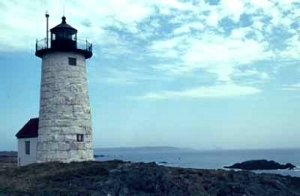
Libby Island Lighthouse, Maine
Flash followed Keeper Gleason Colbeth everywhere.
Keeper at Libby Island Light, Maine, Colbeth said his medium brown Irish setter was so intelligent she could almost talk. And being the devoted pet that she was, Flash never let her master out of her sight. If Colbeth went to the 1823 stone lighthouse, Flash was at his side. If the keeper went to the fog signal house, Flash walked behind, trained so her master wouldn’t trip over her in the dark.
True to her breed, Flash was a great retriever. When Keeper Colbeth went bird hunting, Flash fetched the fowl that fell in the water, no matter how rough the sea was. The dog was the keeper’s best friend, and he said his fifty-pound companion served with him at the light, like a canine assistant.
Flash’s loyalty went above and beyond duty, as Colbeth found out one day. The keeper had to go ashore to get the mail and supplies. Colbeth told his assistant keeper to keep Flash in her quarters until enough time had passed for him to reach the mainland, three miles away. While onshore, the keeper spent about three hours running errands before returning to his boat.
What a surprise he had when he saw the boat! Flash was sitting in it, wet and tired, waiting for her master. Obviously, his faithful companion was willing to make great effort to stay with him and be at his side.
Keeper Colbreth later wrote “The old saying is that ‘A dog is man’s best friend,’ but I would rather put it this way – God first, then the wife, then the dog.”
The Bible says there is another who stays by our side. Jesus said, “I am with you always, even unto the end of the world.” Matthew 28:20 (KJV)
Isn’t it nice to know we have such a faithful companion?
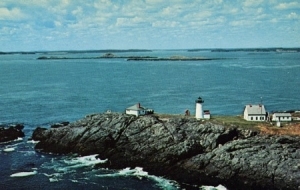
1960’s postcard of Libby Island Lighthouse
This story was found in the book Lighthouses of the Sunrise County, by Timothy Harrison.
May 20, 2016
Seals and Lighthouses

Angels Gate Lighthouse, CA, photo courtesy lighthousefriends.com
Lighthouse keepers develop a relationship with the sea and learn to appreciate its personality. They also acquire an understanding of the creatures that live within it.
Marine animals can provide food for the keepers, but they can also provide company.
Along the west coast of the United States, lighthouse keepers are very familiar with seals and sea lions.
At Angel’s Gate Lighthouse in California, also known as Los Angeles Harbor Light, the three male keepers welcomed the visit of a seal pup that brought entertainment and delight to their mundane duties. “Charlie,” as they named him, appeared in the engine room of the lighthouse one day, apparently attracted by the refuse the keepers tossed out.
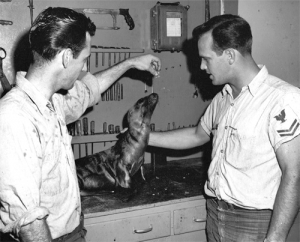
Charlie the Seal and his friends, photo courtesy USCG
Since the Coast Guard allowed pets at lighthouses, the men fed Charlie table scraps and even caught fish for him. Eventually, the little seal followed them everywhere, even into the tower itself.
On the remote Farallon Islands some twenty miles from the coast of San Francisco, there are few inhabitants, except when the migrating seal herds appear for their annual visit. During that time, thousands of seals line the shore where they have their young before traveling on.
When Keeper Max Schlederer was assigned to the Southeast Farallon Island Lighthouse, he could only communicate with his girlfriend Jackie by writing letters. One night while on duty, Max heard the voice of a crying seal pup. When he found the pup, he realized it had been left behind by the herd because it was blind.
Max took the little seal into the lighthouse and put it into a tub of water. He began to apply poultices and boric acid solutions to the seal’s eyes. The medication worked and the seal regained its eyesight. The baby seal was too young to feed on its own, so the keepers started feeding it, first with bread and milk, then fish and abalone as it grew larger. Oscar must have thought Max was his mother, following him around and even sleeping under the bed in his tub.
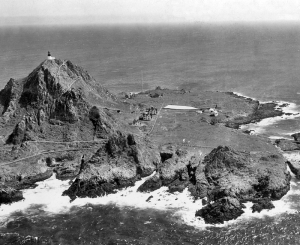
Farallon Islands, photo courtesy USCG
Max’s letters to Jackie were filled with stories about Oscar. In one, Max described how he ended up teaching the seal to swim. When Max first put Oscar back into the sea, the seal sank, and Max had to dive in to save it. Thus began swimming lessons as Max showed Oscar what its mother would have taught him.
When Max proposed to Jackie, she eagerly accepted, having been impressed by his kindness and gentleness by the way he cared for Oscar. They married and Jackie moved to the lighthouse with Max. Each spring they watched the seals return and hoped that Oscar, now grown and reunited with the herd, was one of them.
“The righteous care for the needs of their animals,” Proverbs 12:10
*For more information on this story, see ahttp://www.lighthousedigest.com/Diges...
May 7, 2016
A Lighthouse Mother and Her Castle on the Water
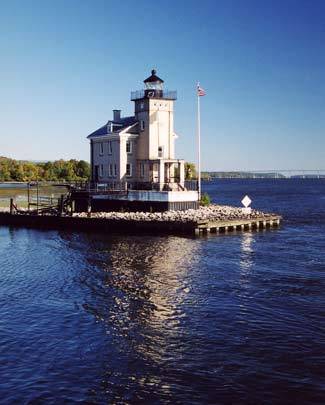
Rondout Creek Lighthouse, NY, courtesy lighthousefriends.com.
Hudson River, NY, 1857
When George Murdock, the keeper at Rondout Creek lighthouse, didn’t return with the supplies, his wife Catherine knew something had happened. Her worries were confirmed when officials from the mainland arrived to tell her he had drowned on his way back to the lighthouse. With a new baby and two small children, Catherine’s life was turned upside down. There was no time to mourn – her children’s survival was her priority.
As Catherine said later, “It was a sore time for me – no one to help, but the light – taking care of that as I had to—did help me bear up. I kept on for a month after the funeral cleaning and tending the lights, and in the winter, after navigation had stopped, some good friends gave me letters and on I went to Washington with this big boy here (pointing to her son James) just a baby in my arms. I wanted to be made lighthouse keeper of Rondout. At first the gentlemen at Washington told me it was impossible, the board didn’t employ women, and besides there was my infant. But I said, ‘Gentlemen, I’m a-going to bring him up to be a lighthouse keeper, and where could he learn it so well as in a lighthouse, and who could teach him better, d’ya think, than his own mother who knows well how to care for the light.’”
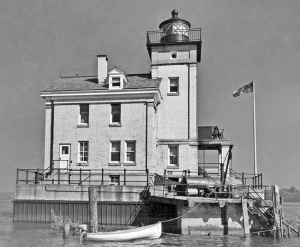
Rondout Creek Lighthouse, 1943, photo courtesy USCG
Her persuasive logic won her the post, and she became the lighthouse keeper. Not only did she gain the position, she received a new kitchen range because she told the men in Washington that she needed one.
The wooden lighthouse situated on the Hudson River at the entrance to Rondout Creek, a busy harbor for the export of coal, weathered many severe storms and spring flooding. One storm was so fierce that Catherine said “the house rocked to and fro like a church steeple.” She told of a terrifying night in 1878 when a heavy snowstorm turned to rain, and friends urged her to abandon the lighthouse and go to the mainland, but Catherine wouldn’t leave. “The safety of the lives of many boatmen depend upon the lights being lit in the tower. I will never desert my post of duty.”

Rondout Creek Lighthouse
When the Eddyville dam ruptured upstream, the resulting flood carried away houses, barns, barges, and boats. In the darkness, Catherine heard the sound of rushing water and crash of debris as it went downriver, but she continued to keep the light beaming all night. The next morning she surveyed the disastrous scene, amazed that the lighthouse had sustained little damage. The local newspaper called her home a “waterborne castle,” and so it was, withstanding the onslaught of the flood.
Catherine kept the Rondout Creek Light, both the old wooden one and its stone replacement, for fifty years, the only female keeper at the light. True to her word, her son James became assistant keeper, then principle keeper when she retired.
Who, indeed, could teach him better than his own mother?
Catherine taught her children by her example of hard work and commitment. Instead of giving up, she pursued her position. Instead of accepting the status quo and “no” for an answer, she persuaded the lighthouse authorities to see her value. And instead of permitting fear to weaken her resolve, she persisted in her duty.
Her life illustrated Proverbs 22:6 in the Bible: “Train up a child in the way he should go,
And when he is old he will not depart from it.” Proverbs 22:6 (NKJV)
She also lived Proverbs 31: 27-28: “She watches over the ways of her household,
And does not eat the bread of idleness. Her children rise up and call her blessed;” (NKJV)
May God shower His blessings on our mothers.
For more on this story, see http://lighthousedigest.com/Digest/St....
April 28, 2016
To Have and To Hold On! – Lighthouse Weddings

Mile Rocks Lighthouse, CA, old postcard courtesy Lighthouse Digest.
Weddings take place in a variety of places. In addition to traditional church weddings, many couples opt for more picturesque or unique settings. From beaches to gardens to mountaintops, marriages are performed in places significant to the two being wed.
Lighthouses have long been chosen for wedding sites. In the past, weddings of lighthouse keepers’ children often took place at lighthouses or keepers’ houses, as that was the most practical location. Today, many couples love the romantic atmosphere a lighthouse can add to the ceremony and the wonderful setting it provides for wedding pictures.
But some couples go to great lengths, or heights, to have more unique weddings.
One such example happened at Mile Rocks Lighthouse which stood south of the Golden Gate Bridge near the entrance to the harbor of San Francisco, CA. Called “The Wedding Cake Lighthouse,” the lighthouse resembled a wedding cake with its three different size tiers topped by the lantern room.
Not only was the location unique – it was dangerous to reach, set on top of rocks and accessed by a boat, then climbed by way of a Jacob’s ladder. Rough seas could make a boat’s approach difficult and could also prove challenging and possibly life-threatening to someone climbing the ladder, as history has shown.
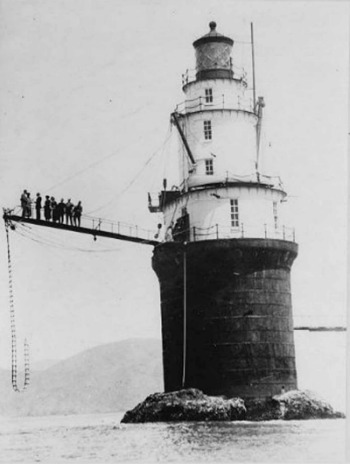
Wedding at Mile Rocks Lighthouse, CA, photo from Library of Congress, courtesy of Lighthouse Digest Magazine
But two vaudeville performers took the risk when they wed at Mile Rocks in 1924. Married high above the water on the gangplank of the lighthouse, the couple became Mr. and Mrs. Ole Olson, and their wedding photograph is now preserved in the Library of Congress.
Wherever weddings take place, the result is a marriage. As my oldest son gets married this weekend, I’m thankful it won’t take place on the gangplank of a lighthouse. And I’m deeply thankful for this blessed event between him and his wonderful fiancé as they become one.
“He who finds a wife finds what is good and receives favor from the Lord.” Proverbs 18:22
“For more on this story, see http://www.lighthousedigest.com/diges...
April 22, 2016
Keeping the Faith at the Lighthouse
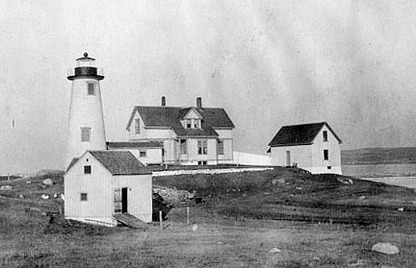
Cuttyhunk Lighthouse, MA, 1891, photo courtesy USCG
Cuttyhunk Lighthouse, at the western end of Cuttyhunk Island, provided guiding light into both Buzzard’s Bay on one side and Vineyard Sound on the other. The two-mile-long island was home to lighthouse keepers and their families for many years, beginning in 1823.
In 1911, Levi B. Clark became Cuttyhunk’s keeper and moved to the island with his wife Sophia and two children. During their stay on the island, their third child was born.
There were many challenges to family life at an offshore location, and special attention was given to providing the children with a proper education.
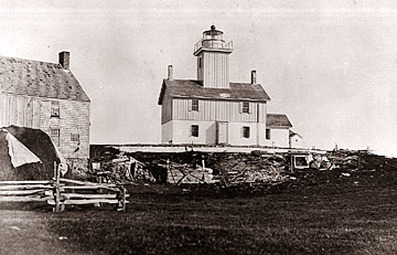
Cuttyhunk Lighthouse, 1880’s, photo courtesy USCG
The Clarks also wanted their children to have spiritual teaching as well, but attending church services was extremely difficult. Keeper Clark decided to handle this aspect of his children’s growth by acquiring a license as an Episcopalian lay reader. Keeper Clark began preaching to his family and any others who happened to be on the island, which included tourists during the summer. In August 1913, Clark preached to a crowd of over 200 vacationers and promised he’d continue to preach every Sunday as long as one person attended.
In the Bible, chapter two of Luke, verse 52, Jesus is described as growing in wisdom and stature, and in favor with God and man. Known as four-dimensional growth, the verse refers to educational growth, physical growth, spiritual growth and social growth. Keeper Clark and his wife went to great lengths to supply all these aspects of growth for their children. Are we doing this today? Would the world be different if we did?
“Fathers, do not exasperate your children; instead, bring them up in the training and instruction of the Lord.” Ephesians 6:4 (NIV)
*Special thanks to Kraig Anderson @lighthousefriends.com, for sharing this story.
April 16, 2016
The Lighthouse Keeper who came back from the Dead
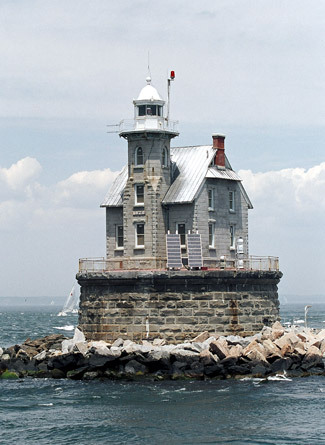
Race Rock Lighthouse, NY, photo courtesy lighthousefriends.com
Off the eastern end of Long Island Sound, you’ll find Fishers, Little Gull, Great Gull, and Plum – a string of islands. Many ships pass between the islands, but the deepest gap, called “The Race,” is just off the end of Fisher Island near a reef called Race Rock. The dangerous current that flows through the gap has been the doom of many vessels, especially before 1871, when the lighthouse built on the reef became active.
A stag station, the lighthouse housed one keeper and two assistant keepers. The families of the married keepers lived on the mainland, visited when a keeper had leave. Located eight miles off the coast from New Haven, Connecticut, going to and from the lighthouse was sometimes difficult for the keepers, depending on the tide. Waves can run in two directions where the water at the mouth of the Race meets the water of Fisher’s Island Sound. In bad weather, these waves can be quite large.
In April 1892, the new head keeper at Race Rock, twenty-four-year-old Christopher Culver, ran into those huge waves. After a brief shore leave to visit his family in New London, Culver set out to return to the lighthouse in a twelve-foot rowboat with a sail. Captain R.M. Jerome, a retired sea captain, watched Culver as he made his way out to the lighthouse. When Capt. Jerome saw Culver’s sail go down in the rough seas, he reported that the boat had capsized.
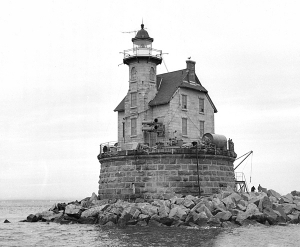
Race Rock Lighthouse, 1965, photo courtesy US Coast Guard
The ensuing search showed no trace of the keeper, and the newspaper reported his drowning.
In reality, Keeper Culver had abandoned his attempt to reach the lighthouse, lowered his sail, and rowed instead to Great Hay Harbor on Fishers Island where he found food and shelter at Mr. Oakley’s farm. Two days later, the keeper arrived back in New London aboard a steamship, and was reunited with his relieved and jubilant family.
At his sixty-ninth wedding anniversary, Culver recalled his premature death notice published sixty-four years before, thankful for the life he’d had since his “death.”
Author Mark Twain faced a similar situation a few years later when he was rumored to have become ill and died while visiting in London. A reporter contacted Twain and told him of the rumor, to which Twain’s oft-misquoted response was, “I have even heard on good authority that I was dead…The report of my death was an exaggeration.”
“You have made known to me the paths of life; you will fill me with joy in your presence.” Acts 2:28

Race Rock Lighthouse, NY
April 8, 2016
The Lighthouse Master Craftsmen
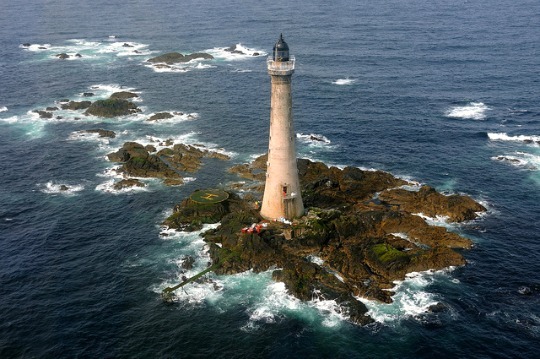
Skerryvore Lighthouse, photo by Ian Cowe
The Stevenson family of Scotland is renown around the world as a dynasty of lighthouse builders. For five generations, the Stevenson’ engineering skills were employed to build structures that are still impressive, having withstood the onslaught of nature and time.
Names like “Skerryvore” and “Bell Rock,” are recognized as icons of lighthouse design and achievement.
“They don’t build them like that anymore,” is a phrase appropriate to lighthouses the family built. No doubt, few lighthouses are still built anywhere anymore, thanks to technological advances like GPS. But beyond the strength and durability the Stevenson lighthouses possess, their attention to detail is not found in modern structures.

Staircase of Buchan Ness Lighthouse, Scotland, photo by Ian Cowe
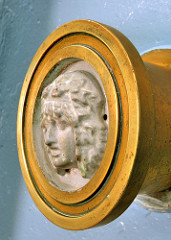
Brass ventilator head, Chanonry Lighthouse, photo by Ian Cowe
Like many present-day structures, form is dictated by functionality and artistic value is often secondary. Even if design is innovative, smaller details are considered unimportant. Not so for the Stevensons, whose buildings showed detail in the most unlikely places.
A ventilator cover, a window astragal (bar separating panes of glass), a stairwell, or an entryway was often decorated like a piece of art instead of a common element in the building. Top quality materials such as brass were employed to add to the imaginative designs.
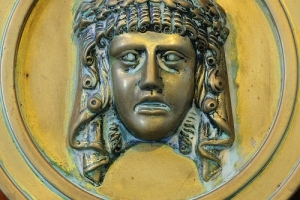
Ventilator Cover, Coversea Lighthouse, Scotland, photo by Ian Cowe
Today, we appreciate such historic details with awe and wonder, signs of the value people had in craftsmanship in the past. These man-made structures are distinguished by their uniqueness.
But do we appreciate the detail found in nature as much? We may marvel at a colorful sunset, a beautiful bird, or an exquisite butterfly, but do we appreciate the intricate detail of the human body?
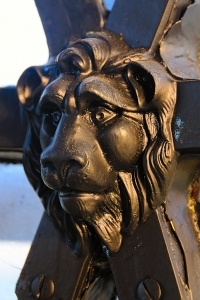
Lion head detail on the lantern astragal, Girdie Ness Lighthouse,, photo by Ian Cowe
A study of the way the body functions with such precision, its components a microscopic factory of working parts all interacting in necessary coordination, shows the amazing detail of our Creator. And not two of us are exactly alike. We are each unique creations, an example of the Master Craftsman’s handiwork.
So the next time you look in the mirror, you can say, “They don’t make them like this anymore.”
“For you created my inmost being;
you knit me together in my mother’s womb.
I praise you because I am fearfully and wonderfully made;
your works are wonderful,” Psalm 139:13-14 (NIV)
*** Photographer Ian Cowe has published a beautiful book, Scottish and Manx Lighthouses, that is full of his wonderful photos.
April 2, 2016
Spring Splendor Arrives at the Lighthouse
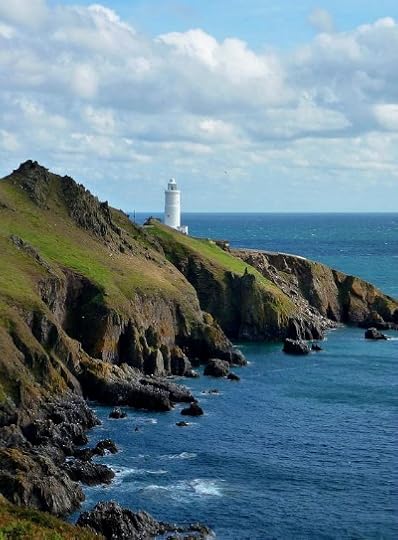
Start Point Lighthouse, Devon, UK
Start Point is one of the most exposed peninsulas on the English Coast, running sharply almost a mile into the sea. The rugged, windswept headland was not a popular assignment for the families of lighthouse keepers sent to the 150-year-old lighthouse situated at the end.
Winters seemed especially long for those stationed there as the wind howled relentlessly, often bringing heavy rain and thunderstorms. The long dreary days took its toll on attitudes and emotions, causing many to hope for transfer to more pleasant places.
Then just when it seemed that winter would never end, the signs of Spring began to appear, and along with them, hope for better days. First, the nights grew shorter as the sun rose earlier, warming the earth. Then the once-fierce winds became milder and more friendly.
But what transformed the island was the appearance of bluebells. Known as the favorite flower in the United Kingdom, these lovely flowers covered the landscape with blankets of blue. And as if their beauty was not enough, the delicious aroma they emit permeated the air.
In the words of former keeper Gordon Partridge, “Suddenly, the bleak and hostile place became beautiful to behold. Mentally, we seemed to change as if uplifted by the arrival of the bluebell. Hundreds of people made the trek to share in the joy, perhaps to picnic and celebrate the passing and ending of wintertime.”
The sound of sheep grazing on the headland, and lambs romping in the meadow added to the delight of the new season. Easter arrived in the midst of this renewal of nature, adding its celebration to the atmosphere, and reminding the keepers of the joy found in new life with Christ. As their environment transformed, so did their attitudes.
As Gordon said, “It felt good to be alive and gifted by serving on this often overlooked, remote place.”
Has springtime arrived where you are? If not, I’ve attached some photos of bluebells to help you make the transition in your mind.
“The flowers appear on the earth; The time of singing has come, And the voice of the turtledove Is heard in our land.” Song of Solomon 2:12 NIV
March 25, 2016
New Book Just Released!
I’m excited to announce the release of my newest book, The Gilded Curse.
No, it’s not about lighthouses, but there’s a lighthouse in it, of course! If you like historical suspense novels, you’ll like The Gilded Curse. Here’s a preview:
In 1942, Lexie Smithfield becomes the only heir to her family’s dwindling fortune after her brother is killed at Pearl Harbor. A mysterious telegram beckons her back to Jekyll Island. Ten years before, the family quit coming to the exclusive Millionaire’s Club after tragic events convinced her mother the island was cursed. Club Superintendent Russell Thompson knows the truth, but he swore never to tell. Will he and Lexie discover the real danger before it’s too late?
Get your copy now on Amazon or your local bookstore. http://www.amazon.com/Gilded-Curse-Ma...
A Symbol of Hope

Blackistone Lighthouse
For many people throughout the world and the ages, a lighthouse has come to represent many things. A sailor seeking safe passageway through dangerous waters welcomed the sight of a lighthouse to guide the way. It not only told him where he was, but warned him of danger. For some, the sight of a lighthouse gave them relief that land was near, a sign that their long and often perilous journey was coming to an end.
It was a symbol of hope, strength and stability, a symbol of security and reliability.
The cross is another symbol representing many things to many people. Where once an instrument of torture, it is now used around the world to commemorate the supreme sacrifice of Jesus, that sacrifice we recognize especially at Easter. It too, represents spiritual strength, stability, security and reliability – characteristics Christ demonstrated in his love for us as he accepted the pain of the cross for our salvation.
Each lighthouse has a place in history and the lives it saved. However, that salvation was temporary to a mortal life.
The salvation the cross represents, though, is eternal. For those seeking a true, life-changing experience, they must come to the spiritual cross of Jesus, the only lasting symbol of hope.
May God richly bless you during this season of hope.
“But he was pierced for our transgressions, he was crushed for our iniquities; the punishment that brought us peace was upon him, and by his wounds we are healed.” Isaiah 53:5









